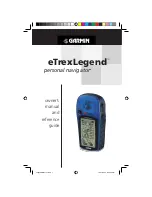
GPS in Schools – Worksheet 2
Produced by the University of Tasmania in conjunction with Geoscience Australia as part of the AuScope GPS in Schools Project – 2014.
3
Australian Curriculum Content Descriptors: ACSIS124, ACHGS048, ACHGS050, ACHGS052, ACSIS146,
ACHGK053, ACHGS058, ACHGS060
Worksheet 2 – Part 1 (GPS Practical)
Instructions:
Refer to your GPS receiver’s user manual and the ‘Basic Receiver Operation’ guide to complete the
following exercise. If you are using a mobile device for this activity (e.g. phone or tablet), the MotionX-GPS (iOS)
or GPS Essentials (Android) apps are recommended.
1.
Head to a clear area and turn on the GPS receiver or open the GPS app on your mobile device. Find the
signal strength indicator and describe the signal strength at your location. What happens if you cover the
receiver with your hand? Does your GPS display its accuracy? If so, does it decrease?
Students should see the GPS signal strength decrease when a hand is used to block the antenna, and
the accuracy should become worse as a result. Vice versa should occur when the hand is removed.
2.
With the receiver uncovered, walk until you’re up against a building or other large object. What happens to
the satellite signal now? Why?
As the student walks closer to the building, the visible sky view for the GPS receiver will decrease. This
should cause a reduction in the number of satellites being tracked, and lead to a reduction in GPS
accuracy.
3.
Find a long, straight-line feature (at least 100 m in length, e.g. the edge of a soccer pitch) and note its
distance and bearing using a tape measure and traditional compass.
Distance: __________________________
Bearing: __________________________
4.
Using your GPS app or receiver, start recording a track and walk along the edge of the straight-line
feature. Once finished, save your track with a relevant name for use in Part 2.
5.
Swap to the page that displays your speed. Walk along the same straight-line feature and note your
average speed below.
Average Walking Speed: _______________________________
6.
Using a stopwatch, time how long it takes you (in seconds) to walk along the length of the straight line
feature. Using this information, manually calculate your speed (in km/h) using the formula on the right. How
does it compare with the average walking speed from Question 5?
___________________________________________
___________________________________________
___________________________________________
______________________________________________________________________________________
______________________________________________________________________________________
𝑆𝑝𝑒𝑒𝑑
(
𝑘𝑚
/
ℎ
) =
𝐷𝑖𝑠𝑡𝑎𝑛𝑐𝑒
(
𝑚
)
𝑇𝑖𝑚𝑒
(
𝑠
)
∗
3.6



































